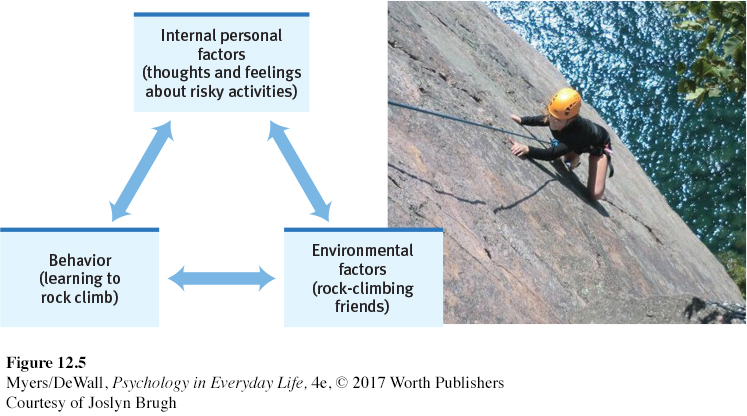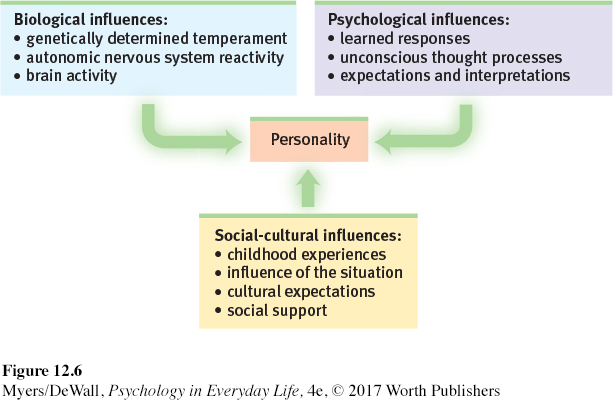12.5 Social-Cognitive Theories
LOQ 12-
Reciprocal Influences
reciprocal determinism the interacting influences of behavior, internal personal factors, and environment.
So, our personal traits interact with our environment to influence our behavior. Albert Bandura (1986, 2006, 2008) called this process reciprocal determinism. “Behavior, internal personal factors, and environmental influences,” he said, “all operate as interlocking determinants of each other” (FIGURE 12.5).

social-
self-
The social-
Roughly speaking, the short-
We can see this interaction in people’s relationships. For example, Rosa’s romantic history (past behavior) influences her attitudes toward new relationships (internal factor), which affects how she now responds to Ryan (environmental factor). Social-
Different people choose different environments. What school do you attend? What do you read? What shows do you watch? What music do you listen to? With whom do you enjoy spending time? All these choices are part of an environment you are choosing, based partly on your personality (Ickes et al., 1997). We choose our environment, and it then shapes us.
Our personalities shape how we interpret and react to events. Anxious people tend to attend and react strongly to relationship threats (Campbell & Marshall, 2011). If we perceive the world as threatening, we will watch for threats and be prepared to defend ourselves.
Our personalities help create situations to which we react. How we view and treat people influences how they then treat us. If we expect that others will not like us, our desperate attempts to seek their approval might cause them to reject us. Depressed people often engage in this excessive reassurance seeking, which may confirm their negative self-
views (Coyne, 1976a,b).
In addition to the interaction of internal personal factors, the environment, and our behaviors, we also experience gene-
In such ways, we are both the products and the architects of our environments. Boiling water turns an egg hard and a noodle soft. Academic challenges turn one person into a success and another toward collapse (Harms et al., 2006). At every moment, our behavior is influenced by our biology, our social and cultural experiences, and our thought processes and traits (FIGURE 12.6).

Retrieve + Remember
Question 12.11
•Albert Bandura proposed the _____-_____ perspective on personality, which emphasizes the interaction of people with their environment. To describe the interacting influences of behavior, thoughts, and environment, he used the term _____ _____.
ANSWERS: social-
Assessing Behavior in Situations
To predict behavior, social-
These assessment exercises have some limitations. They may not reveal less visible but important characteristics, such as inner achievement drive (Bowler & Woehr, 2006). These procedures do exploit a valid principle: The best way to predict future behavior is neither a personality test nor an interviewer’s intuition; rather, it is the person’s past behavior patterns in similar situations (Lyons et al., 2011; Mischel, 1981; Schmidt & Hunter, 1998).
Evaluating Social-Cognitive Theories
LOQ 12-
Social-
| Personality Theory | KeyProponents | Assumptions | View of Personality | Personality Assessment Methods |
|---|---|---|---|---|
| Psychoanalytic | Freud | Emotional disorders spring from unconscious dynamics, such as unresolved sexual and other childhood conflicts, and fixation at various developmental stages. Defense mechanisms fend off anxiety. | Personality consists of pleasure- |
Free association, projective tests, dream analysis |
| Psychodynamic | Adler, Horney, Jung | The unconscious and conscious minds interact. Childhood experiences and defense mechanisms are important. | The dynamic interplay of conscious and unconscious motives and conflicts shapes our personality. | Projective tests, therapy sessions |
| Humanistic | Rogers, Maslow | Rather than examining the struggles of sick people, it’s better to focus on the ways healthy people strive for self- |
If our basic human needs are met, we will strive toward self- |
Questionnaires, therapy sessions |
| Trait | Allport, Eysenck, McCrae, Costa | We have certain stable and enduring characteristics, influenced by genetic predispositions. | Scientific study of traits has isolated important dimensions of personality, such as the Big Five traits (conscientiousness, agreeableness, neuroticism, openness, and extraversion). | Personality inventories |
| Social- |
Bandura | Our traits interact with the social context to produce our behaviors. | Conditioning and observational learning interact with cognition to create behavior patterns. | Our behavior in one situation is best predicted by considering our past behavior in similar situations. |
Critics charge that social-
Retrieve + Remember
Question 12.12
•What is the best way to predict a person’s future behavior?
ANSWER: Examine the person’s past behavior patterns in similar situations.